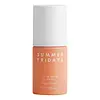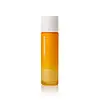What's inside
What's inside
 Key Ingredients
Key Ingredients

 Benefits
Benefits

 Concerns
Concerns

 Ingredients Side-by-side
Ingredients Side-by-side

Water
Skin ConditioningNiacinamide
SmoothingButylene Glycol
Humectant3-O-Ethyl Ascorbic Acid
Skin ConditioningAscorbyl Glucoside
AntioxidantGlycerin
HumectantCapryloyl Glycerin/Sebacic Acid Copolymer
Skin ConditioningHydroxyethyl Acrylate/Sodium Acryloyldimethyl Taurate Copolymer
Emulsion StabilisingSqualane
EmollientSodium Citrate
BufferingPhenoxyethanol
PreservativeSodium Hydroxide
BufferingCitric Acid
BufferingDiheptyl Succinate
EmollientTocopheryl Acetate
AntioxidantXanthan Gum
EmulsifyingTetrasodium Glutamate Diacetate
Carbomer
Emulsion StabilisingPolysorbate 20
EmulsifyingPalmitoyl Oligopeptide
CleansingPalmitoyl Tetrapeptide-7
Skin ConditioningCamellia Oleifera Leaf Extract
AstringentEthylhexylglycerin
Skin ConditioningOrchis Mascula Flower Extract
SoothingCaprylic/Capric Triglyceride
MaskingCananga Odorata Flower Extract
PerfumingCucumis Melo Cantalupensis Fruit Extract
AstringentEugenia Caryophyllus Flower Extract
AstringentGlycine Soja Oil
EmollientPyrus Malus Fruit Extract
Skin ConditioningPrunus Armeniaca Fruit Extract
Skin ConditioningRosa Gallica Flower Extract
AstringentCinnamomum Cassia Bark Extract
MaskingJasminum Officinale Flower/Leaf Extract
MaskingCoffea Arabica Leaf/Seed Extract
MaskingCamellia Sinensis Leaf Extract
AntimicrobialAmyl Cinnamal
PerfumingCinnamyl Alcohol
PerfumingCitronellol
PerfumingEugenol
PerfumingHydroxycitronellal
PerfumingWater, Niacinamide, Butylene Glycol, 3-O-Ethyl Ascorbic Acid, Ascorbyl Glucoside, Glycerin, Capryloyl Glycerin/Sebacic Acid Copolymer, Hydroxyethyl Acrylate/Sodium Acryloyldimethyl Taurate Copolymer, Squalane, Sodium Citrate, Phenoxyethanol, Sodium Hydroxide, Citric Acid, Diheptyl Succinate, Tocopheryl Acetate, Xanthan Gum, Tetrasodium Glutamate Diacetate, Carbomer, Polysorbate 20, Palmitoyl Oligopeptide, Palmitoyl Tetrapeptide-7, Camellia Oleifera Leaf Extract, Ethylhexylglycerin, Orchis Mascula Flower Extract, Caprylic/Capric Triglyceride, Cananga Odorata Flower Extract, Cucumis Melo Cantalupensis Fruit Extract, Eugenia Caryophyllus Flower Extract, Glycine Soja Oil, Pyrus Malus Fruit Extract, Prunus Armeniaca Fruit Extract, Rosa Gallica Flower Extract, Cinnamomum Cassia Bark Extract, Jasminum Officinale Flower/Leaf Extract, Coffea Arabica Leaf/Seed Extract, Camellia Sinensis Leaf Extract, Amyl Cinnamal, Cinnamyl Alcohol, Citronellol, Eugenol, Hydroxycitronellal
Water
Skin ConditioningLactobacillus Ferment
Skin Conditioning3-O-Ethyl Ascorbic Acid
Skin ConditioningNiacinamide
SmoothingHyaluronic Acid
HumectantSodium Hyaluronate
HumectantPanthenol
Skin ConditioningSodium Polyglutamate
HumectantTocopherol
AntioxidantGlycerin
HumectantCitrus Aurantium Dulcis Peel Extract
Emulsion StabilisingCitrus Aurantium Dulcis Callus Culture Extract
Skin ConditioningCitrus Sinensis Fruit Extract
AntioxidantCitrus Aurantium Dulcis Fruit Extract
MaskingCitrus Aurantium Dulcis Oil
MaskingHippophae Rhamnoides Extract
MaskingLycium Barbarum Fruit Extract
AstringentRosa Canina Fruit Extract
AstringentCitrus Limon Fruit Extract
MaskingGluconolactone
Skin ConditioningLithothamnion Calcareum Extract
Skin ConditioningHelianthus Annuus Seed Oil
EmollientChondrus Crispus Extract
Skin ConditioningLeuconostoc/Radish Root Ferment Filtrate
AntimicrobialCitric Acid
BufferingSodium Riboflavin Phosphate
Skin ConditioningSodium Tocopheryl Phosphate
AntioxidantSodium Citrate
BufferingPotassium Hydroxide
BufferingXanthan Gum
EmulsifyingSodium Benzoate
MaskingCalcium Gluconate
HumectantTriethylhexanoin
MaskingPolyglyceryl-3 Laurate
EmulsifyingAcrylates/C10-30 Alkyl Acrylate Crosspolymer
Emulsion StabilisingPentaerythrityl Tetra-Di-T-Butyl Hydroxyhydrocinnamate
AntioxidantPhenoxyethanol
PreservativeChlorphenesin
AntimicrobialTriethyl Citrate
MaskingLimonene
PerfumingLinalool
PerfumingCitral
PerfumingWater, Lactobacillus Ferment, 3-O-Ethyl Ascorbic Acid, Niacinamide, Hyaluronic Acid, Sodium Hyaluronate, Panthenol, Sodium Polyglutamate, Tocopherol, Glycerin, Citrus Aurantium Dulcis Peel Extract, Citrus Aurantium Dulcis Callus Culture Extract, Citrus Sinensis Fruit Extract, Citrus Aurantium Dulcis Fruit Extract, Citrus Aurantium Dulcis Oil, Hippophae Rhamnoides Extract, Lycium Barbarum Fruit Extract, Rosa Canina Fruit Extract, Citrus Limon Fruit Extract, Gluconolactone, Lithothamnion Calcareum Extract, Helianthus Annuus Seed Oil, Chondrus Crispus Extract, Leuconostoc/Radish Root Ferment Filtrate, Citric Acid, Sodium Riboflavin Phosphate, Sodium Tocopheryl Phosphate, Sodium Citrate, Potassium Hydroxide, Xanthan Gum, Sodium Benzoate, Calcium Gluconate, Triethylhexanoin, Polyglyceryl-3 Laurate, Acrylates/C10-30 Alkyl Acrylate Crosspolymer, Pentaerythrityl Tetra-Di-T-Butyl Hydroxyhydrocinnamate, Phenoxyethanol, Chlorphenesin, Triethyl Citrate, Limonene, Linalool, Citral
 Reviews
Reviews

Ingredients Explained
These ingredients are found in both products.
Ingredients higher up in an ingredient list are typically present in a larger amount.
You might know this ingredient as Ethyl Ascorbic Acid, a more stable version of ascorbic acid.
Like other types of vitamin C, this ingredient has many benefits including reducing wrinkles, skin soothing, dark spot fading, and fighting against free radicals.
3-O-Ethyl Ascorbic Acid interferes with the process of skin darkening, helping to reduce hyperpigmentation. It also encourages the skin to produce more collagen.
Once applied, 3-O-Ethyl Ascorbic Acid is converted to Vitamin C deeper in the skin's layers. This process is slow but makes this ingredient more tolerable for skin.
The optimum pH range for this ingredient is 4 - 5.5
Learn more about 3-O-Ethyl Ascorbic AcidCitric Acid is an alpha hydroxy acid (AHA) naturally found in citrus fruits like oranges, lemons, and limes.
Like other AHAs, citric acid can exfoliate skin by breaking down the bonds that hold dead skin cells together. This helps reveal smoother and brighter skin underneath.
However, this exfoliating effect only happens at high concentrations (20%) which can be hard to find in cosmetic products.
Due to this, citric acid is usually included in small amounts as a pH adjuster. This helps keep products slightly more acidic and compatible with skin's natural pH.
In skincare formulas, citric acid can:
While it can provide some skin benefits, research shows lactic acid and glycolic acid are generally more effective and less irritating exfoliants.
Most citric acid used in skincare today is made by fermenting sugars (usually from molasses). This synthetic version is identical to the natural citrus form but easier to stabilize and use in formulations.
Read more about some other popular AHA's here:
Learn more about Citric AcidGlycerin is already naturally found in your skin. It helps moisturize and protect your skin.
A study from 2016 found glycerin to be more effective as a humectant than AHAs and hyaluronic acid.
As a humectant, it helps the skin stay hydrated by pulling moisture to your skin. The low molecular weight of glycerin allows it to pull moisture into the deeper layers of your skin.
Hydrated skin improves your skin barrier; Your skin barrier helps protect against irritants and bacteria.
Glycerin has also been found to have antimicrobial and antiviral properties. Due to these properties, glycerin is often used in wound and burn treatments.
In cosmetics, glycerin is usually derived from plants such as soybean or palm. However, it can also be sourced from animals, such as tallow or animal fat.
This ingredient is organic, colorless, odorless, and non-toxic.
Glycerin is the name for this ingredient in American English. British English uses Glycerol/Glycerine.
Learn more about GlycerinNiacinamide is a multitasking form of vitamin B3 that strengthens the skin barrier, reduces pores and dark spots, regulates oil, and improves signs of aging.
And the best part? It's gentle and well-tolerated by most skin types, including sensitive and reactive skin.
You might have heard of "niacin flush", or the reddening of skin that causes itchiness. Niacinamide has not been found to cause this.
In very rare cases, some individuals may not be able to tolerate niacinamide at all or experience an allergic reaction to it.
If you are experiencing flaking, irritation, and dryness with this ingredient, be sure to double check all your products as this ingredient can be found in all categories of skincare.
When incorporating niacinamide into your routine, look out for concentration amounts. Typically, 5% niacinamide provides benefits such as fading dark spots. However, if you have sensitive skin, it is better to begin with a smaller concentration.
When you apply niacinamide to your skin, your body converts it into nicotinamide adenine dinucleotide (NAD). NAD is an essential coenzyme that is already found in your cells as "fuel" and powers countless biological processes.
In your skin, NAD helps repair cell damage, produce new healthy cells, support collagen production, strengthen the skin barrier, and fight environmental stressors (like UV and pollution).
Our natural NAD levels start to decline with age, leading to slower skin repair, visible aging, and a weaker skin barrier. By providing your skin niacinamide, you're recharging your skin's NAD levels. This leads to stronger, healthier, and younger looking skin.
Another name for vitamin B3 is nicotinamide. This vitamin is water-soluble and our bodies don't store it. We obtain Vitamin B3 from either food or skincare. Meat, fish, wheat, yeast, and leafy greens contain vitamin B3.
The type of niacinamide used in skincare is synthetically created.
Learn more about NiacinamidePhenoxyethanol is a preservative that has germicide, antimicrobial, and aromatic properties. Studies show that phenoxyethanol can prevent microbial growth. By itself, it has a scent that is similar to that of a rose.
It's often used in formulations along with Caprylyl Glycol to preserve the shelf life of products.
Sodium Citrate is the sodium salts of citric acid. In skincare, it is used to alter pH levels and acts as a preservative.
Its main functions are to maintain the pH of a product and neutralize metal ions.
The acidity of our skin is maintained by our glands and skin biome; normal pH level of skin is slightly acidic (~4.75-5.5).
Being slightly acidic allows our skin to create an "acid mantle". This acid mantle is a thin barrier that protects our skin from bacteria and contaminants.
Learn more about Sodium CitrateWater. It's the most common cosmetic ingredient of all. You'll usually see it at the top of ingredient lists, meaning that it makes up the largest part of the product.
So why is it so popular? Water most often acts as a solvent - this means that it helps dissolve other ingredients into the formulation.
You'll also recognize water as that liquid we all need to stay alive. If you see this, drink a glass of water. Stay hydrated!
Learn more about WaterXanthan gum is used as a stabilizer and thickener within cosmetic products. It helps give products a sticky, thick feeling - preventing them from being too runny.
On the technical side of things, xanthan gum is a polysaccharide - a combination consisting of multiple sugar molecules bonded together.
Xanthan gum is a pretty common and great ingredient. It is a natural, non-toxic, non-irritating ingredient that is also commonly used in food products.
Learn more about Xanthan Gum